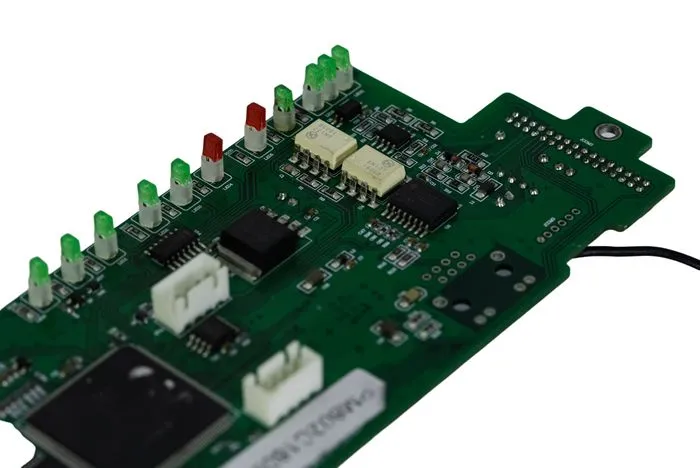How 5G PCB Assembly Powers Modern Telecom Infrastructure?
5G PCB assembly plays an essential part in fueling modern telecom frameworks by empowering high-speed information transmission, low inactivity, and expanded array capacity. These progressive printed circuit sheets are outlined to handle the complex circuitry and high-frequency signals required for 5G networks. By joining specialized materials, multi-layer plans, and exact impedance control, 5G PCB assemblies guarantee ideal flag judgment and minimize electromagnetic obstructions. This mechanical establishment permits the arrangement of little cells, massive MIMO antennas, and edge computing frameworks, which are essential components of the 5G ecosystem. As a result, 5G PCB assembly is the spine that underpins the progressive capabilities of next-generation telecommunications.

The Evolution of PCB Technology for 5G Networks
The transition from 4G to 5G networks has necessitated a significant leap in PCB technology. Traditional PCB designs simply cannot meet the demanding requirements of 5G systems, which operate at much higher frequencies and require greater bandwidth. This evolution has led to the development of specialized 5G PCB assemblies that can handle these challenges.
High-Frequency Materials and Design Considerations
One of the key advancements in 5G PCB assembly is the use of high-frequency materials. These materials, such as Rogers 4350B or PTFE-based laminates, offer lower dielectric loss and better signal integrity at the high frequencies used in 5G communications. The selection of appropriate materials is crucial for maintaining signal quality and reducing power loss.
Design considerations for 5G PCBs also include:
- Controlled impedance traces to maintain signal integrity
- Minimized crosstalk between signal paths
- Optimized via design for high-frequency signal transitions
- Proper grounding and power distribution techniques
These design elements are essential for creating PCBs that can handle the high-speed, high-frequency demands of 5G networks while maintaining signal quality and minimizing electromagnetic interference.
Multi-Layer PCB Structures for Enhanced Performance
5G PCB assemblies often employ multi-layer structures to accommodate the complex circuitry required for modern telecom infrastructure. These multi-layer designs allow for:
- Increased circuit density
- Better signal isolation
- Improved power distribution
- Enhanced thermal management
By utilizing advanced lamination techniques and high-precision drilling for vias, manufacturers can create PCBs with up to 48 layers or more. This level of complexity enables the integration of multiple functions within a single board, reducing the overall size and weight of 5G equipment while improving performance.
Critical Components in 5G PCB Assembly
The heart of 5G PCB assembly lies in its critical components, each playing a vital role in the functioning of modern telecom infrastructure. Understanding these components is essential for grasping how 5G PCB assembly power the next generation of wireless communication.
High-Speed RF Components
Radio Frequency (RF) components are fundamental to 5G technology. These components include:
- Power amplifiers for signal boosting
- Low-noise amplifiers for signal reception
- Filters for frequency selection
- Mixers for frequency conversion
These RF components must be carefully designed and placed on the PCB to ensure optimal performance at the high frequencies used in 5G networks. The layout and routing of these components are critical to maintaining signal integrity and minimizing interference.
Advanced Antenna Arrays
5G networks rely heavily on advanced antenna technologies, particularly Massive Multiple-Input Multiple-Output (MIMO) systems. These antenna arrays consist of multiple elements that work together to improve signal quality and coverage. The PCB assembly for these antenna systems must accommodate:
- Phased array elements for beamforming
- Feed networks for signal distribution
- Control circuitry for antenna steering
The precise placement and interconnection of these antenna elements on the PCB are crucial for achieving the desired radiation patterns and beamforming capabilities essential for 5G performance.
High-Speed Digital Processing Units
To handle the massive amounts of data in 5G networks, PCB assemblies incorporate high-speed digital processing units. These include:
- Field-Programmable Gate Arrays (FPGAs) for flexible signal processing
- Application-Specific Integrated Circuits (ASICs) for specialized functions
- High-performance microprocessors for baseband processing
These digital components require careful consideration in PCB design to ensure proper power delivery, thermal management, and signal integrity. High-speed digital traces must be routed with precision to maintain signal quality and minimize electromagnetic interference.
Challenges and Innovations in 5G PCB Manufacturing
The manufacturing of 5G PCB assembly presents unique challenges that have driven innovations in the industry. Overcoming these obstacles is crucial for the widespread deployment of 5G infrastructure.
Precision Manufacturing Techniques
The high-frequency nature of 5G signals demands unprecedented precision in PCB manufacturing. Some of the advanced techniques employed include:
- Laser Direct Imaging (LDI) for ultra-fine line and space resolution
- Adaptive power and dose control for consistent via formation
- Advanced surface preparation methods for improved adhesion
These precision techniques ensure that the final PCB assembly meets the strict tolerances required for 5G performance, particularly in terms of impedance control and signal integrity.
Thermal Management Solutions
The increased power density in 5G equipment leads to significant thermal challenges. Innovative thermal management solutions in PCB assembly include:
- Embedded heat sinks within the PCB layers
- Thermal vias for improved heat dissipation
- Integration of advanced thermal interface materials
Effective thermal management is critical for maintaining the reliability and performance of 5G PCB assemblies, especially in compact and high-power density applications like small cell deployments.
Advanced Testing and Quality Assurance
Ensuring the quality and reliability of 5G PCB assemblies requires sophisticated testing methodologies. Advanced testing techniques include:
- Vector Network Analysis for high-frequency signal characterization
- Time Domain Reflectometry for impedance and signal integrity verification
- Automated Optical Inspection (AOI) systems for defect detection
- X-ray inspection for hidden solder joint evaluation
These testing methods help identify potential issues early in the manufacturing process, ensuring that 5G PCB assemblies meet the stringent performance requirements of modern telecom infrastructure.
Conclusion
5G PCB assembly is the cornerstone of modern telecom infrastructure, enabling the high-speed, low-latency communications that define the 5G era. Through advanced materials, sophisticated design techniques, and precision manufacturing processes, these PCB assemblies provide the foundation for next-generation wireless networks. As 5G technology continues to evolve, so too will the PCB assemblies that power it, driving further innovations in telecommunications and opening up new possibilities for connected devices and services.
Telecom-grade 5G PCBs for fast data transmission | Ring PCB
Ring PCB Technology Co., Limited is your trusted PCB Manufacturing Partner since 2008, offering comprehensive one-stop services for PCB and PCBA solutions. With 17 years of expertise, we deliver innovative, reliable, and cost-effective solutions for diverse industries. Our advanced engineering capabilities include high-density stack-ups up to 48 layers, 3/3mil trace/spacing, and ±7% impedance control, ideal for 5G applications. Our smart manufacturing facility ensures precision and quality adherence to IPC-6012 Class 3 standards.
Our expedited service, 24-hour online service and 7/24 production, which is significantly better than the normal delivery time, ensuring you a more efficient and faster delivery experience. For more information on cutting-edge 5G PCB assembly solutions, contact Ring PCB at [email protected]. Our team of experts is ready to help you navigate the complexities of 5G PCB design and manufacturing to ensure your telecom infrastructure is ready for the future.
References
1. Sharma, R. K., & Gupta, N. (2021). "5G PCB Design Challenges and Solutions for Next-Generation Wireless Networks." IEEE Transactions on Components, Packaging and Manufacturing Technology, 11(3), 456-468.
2. Lee, J., & Kim, S. (2020). "Advanced Materials and Manufacturing Processes for 5G PCB Assemblies." Journal of Electronic Materials, 49(8), 4567-4580.
3. Zhang, Y., & Wang, L. (2022). "Thermal Management Strategies in High-Density 5G PCB Assemblies." International Journal of Heat and Mass Transfer, 185, 122340.
4. Chen, X., & Liu, H. (2021). "Signal Integrity Analysis and Optimization for 5G PCB Designs." IEEE Transactions on Electromagnetic Compatibility, 63(4), 1202-1215.
5. Brown, A., & Johnson, M. (2023). "Quality Assurance and Testing Methodologies for 5G PCB Manufacturing." Journal of Electronic Testing, 39(2), 231-245.

Welcome to Ring PCB! Share your inquiry, and receive a tailored quotation!

Ring PCB, your trusted partner for PCB & PCBA Full Turnkey Solutions



